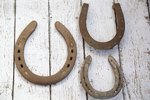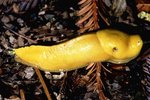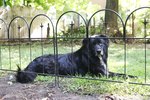Things You'll Need
Water hose
Pet urine removal product for lawns
Rake
Grass seed
Compost or potting soil
Pet urine on grass can cause patches of brown, burned-looking sod, as the roots are damaged by the salts, uric acid or nitrogen content of the urine. Studies indicate the amount of urine, rather than the type (a cat's urine is chemically stronger) is what has the most effect on the lawn. Although a dog typically can produce a greater volume of urine, cats using your yard regularly as a litter box can also cause damage that will require some work to repair.
Spray the urine-soaked grass immediately with pressurized water from a hose to dilute the nitrogen in the urine. Allow to dry.
Apply a product designed to neutralize the chemicals found in pet urine, such as See Spot Run! Lawn Protectant, Lawn Spot Away or Green-UM spray; these can be purchased in pet supply stores, or online. Allow to dry.
Rake the affected area to remove as much of the dead grass as possible.
Cover the dead area with grass seed, applying enough so that seeds are touching, but do not pour on in thick layers. Apply a covering of compost or rich potting soil over the seed.
Water gently with a sprinkler or watering can to saturate the seeds, but avoid washing the compost or dirt away. Continue watering every few days, saturating the soil, until new grass is established.
Tips
If the lawn is already damaged, the urine has already soaked into the roots; however, spraying with water can remove any urine chemicals still clinging to the grass.
Pet urine removers usually kill odors as well.
For quicker lawn repair, you can cut out the affected area and replace it with a piece of established turf sod; water to establish roots.
Warnings
Do not add fertilizer to the affected areas, as this will cause a deeper "burn" of the grass.
References
Photo Credits
-
green and yellow dried catted grass on a field image by Elena Moiseeva from Fotolia.com
Writer Bio
Lori Lapierre holds a Bachelor of Arts and Science in public relations/communications. For 17 years, she worked for a Fortune 500 company before purchasing a business and starting a family. She is a regular freelancer for "Living Light News," an award-winning national publication. Her past writing experience includes school news reporting, church drama, in-house business articles and a self-published mystery, "Duty Free Murder."





